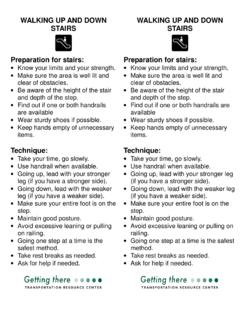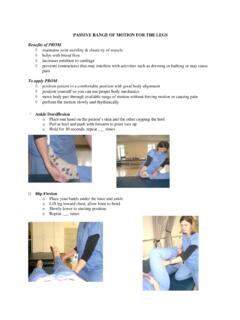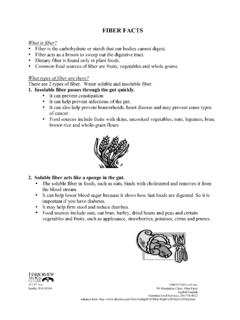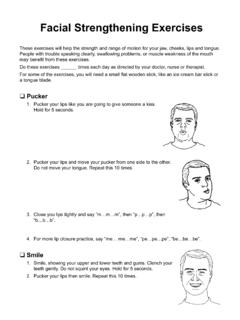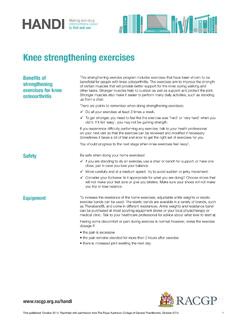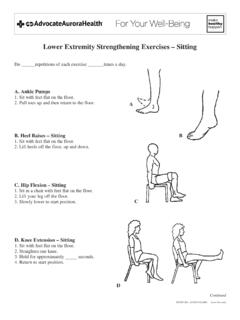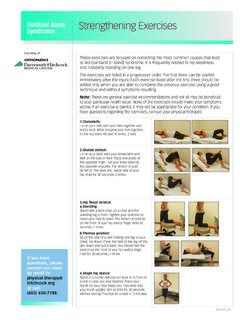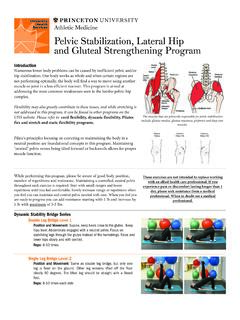Transcription of Strengthening and Optimal Movements for Painful Shoulders ...
1 Strengthening and Optimal Movements for Painful Shoulders eAppendix 1. exercise Instruction Sheet for the Strengthening and Optimal Movements for Painful Shoulders (STOMPS) Trial in Chronic Spinal Cord Injury Instructions: Exercises are to be performed 3 times per week. Allow one rest day between each exercise day. You may divide the exercises into groups and perform them at different times. For example, in the morning perform 1 2 the exercises and in the afternoon perform the other 1 2 OR one day perform 2 groups of exercises (all the sets and repetitions for 2 exercises) and the next day perform the other 2 groups. Mark the calendar to show that you have done the exercises. Use the comment section to write out any problems or changes you experienced. Contact the research staff if you have questions or problems. Terms: Warm-up phase before exercising, perform the warm-up stretching activity as described.
2 This activity is designed to prepare your muscles and joints for the exercises. Sets the completion of one consecutive grouping of repetitions of an exercise . Repetitions the number of times the movement or exercise is repeated without resting within one set Rest period A rest period is specified between each set. The rest time ranges from 30 60 seconds to 60 90. seconds. Resume the exercise as soon as this time has passed. You may perform the active Movements without resistance during the rest period. Do not resume the exercise before the minimum time has passed to avoid fatigue. Example: 3 sets of 15 repetitions perform the exercise 15 times. Rest 60 90 seconds after the 15 repetitions. Repeat for a total of 3 sets. March 2011 (eAppendixes, Mulroy et al) Volume 91 Number 3 Physical Therapy f 1. Strengthening and Optimal Movements for Painful Shoulders eAppendix 1.
3 Continued Warm up Phase Stretching and Active Movements I. Stretching Hold each stretch position for 15 seconds Repeat each stretch 3 to 5 times Do not bounce in stretch position or apply a forceful pull on the muscles or joints. 1) Position wheelchair in a door frame. Place arm in shoul- der extension with external rotation and elbow exten- sion by holding the edge of the door frame with the thumb pointing upward. While holding the door frame, rotate upper body away from the door frame until a gentle stretch is felt. 2) Wrap arm around the front of the upper body, use the other hand to apply gentle pressure just above the elbow to stretch. 3) Hold side of wheelchair seat or lower frame of the wheelchair with one hand, lean away from this arm and side bend the neck away from this side (Continued). 2 f Physical Therapy Volume 91 Number 3 March 2011 (eAppendixes, Mulroy et al).
4 Strengthening and Optimal Movements for Painful Shoulders eAppendix 1. Continued II. Active Movements Before beginning each of the resistance exercises and during rest periods, perform 3 to 5 motions of each activity without resistance. These Movements should be performed gently to help prepare your muscles for the resistance exercises. If you experience any unusual or significant pain with the Movements , try gently stretching the muscles again before starting with the weight or exercise bands. If this pain continues, do not perform the Painful exercises this session. You can perform the other exercises if you are not having the significant pain with those motions. Identify the exercises not performed on your exercise log and indicate that you had pain on that day. If you have to miss more than 2 days of exercise due to this pain, contact the research staff to discuss the problem.
5 1. THUMB UP With your arm straight and thumb 2. ARM ROTATION With your elbow at the side of pointing upward, raise arm out to the side and slightly your body, rotate your forearm and hand away from in front to just below shoulder level. Repeat 3 to 5 your belly out to the side. Repeat 3 to 5 times. times. 3. SHOULDER SQUEEZE Gently squeeze your shoul- 4. ARM DIAGONALS Raise your arm above your head der blades together and downward. Hold for 2 sec- and out to the side. Move your hand toward the onds. Repeat 3 to 5 times. opposite knee. Repeat 3 to 5 times. (Continued). March 2011 (eAppendixes, Mulroy et al) Volume 91 Number 3 Physical Therapy f 3. Strengthening and Optimal Movements for Painful Shoulders eAppendix 1. Continued Resistance Exercises NOTE: Please perform all exercises slowly in both directions. I. Thumb Up exercise With a Handheld Weight Strengthening for endurance Body position: Seated in wheelchair holding a weight with your wheelchair brakes on.
6 Arm position: Start position arm at side of body. Elbow straight, weight in hand or secured on wrist, thumb pointing upward. Motion: 1. Raise arm upward (out to side and slightly forward) to a level that is just below (no higher than) the shoulder in a slow, controlled manner. 2. Return to start position with a slow, controlled motion downward. GOAL. Perform 3 SETS of 15 REPETITIONS. REST for 1 to 2 minutes between SETS. Weight _____. (Continued). 4 f Physical Therapy Volume 91 Number 3 March 2011 (eAppendixes, Mulroy et al). Strengthening and Optimal Movements for Painful Shoulders eAppendix 1. Continued II. Shoulder Rotations With exercise Band Strengthening Wheelchair position: Position chair at a 90-degree angle with band secured to an object on the opposite side of the arm that will be performing the exercises (for example, place handle of exercise band between the door and the door jam and close the door securely).
7 Place your wheelchair brakes on. Body position: Seated in wheelchair with elastic band attached securely to object on the side farthest from the exercise arm. Arm position: Place a towel roll between your side and your elbow and upper arm. Squeeze your elbow gently against the towel roll to keep it in place. Hold the band with your hand beside your stomach, elbow bent at a right angle Motion: 1. Rotate your arm away from your stomach pulling the band out to the side to a point that you feel resistance but you are not forcing the arm outward. Keep the band level with the floor and your wrist straight during the movement. Keep your elbow by your side, holding the towel roll in place between your arm and body. 2. Hold the end position for 1 second. 3. Return to start position with a slow, controlled motion as your hand returns to a position against your stomach.
8 GOAL. Perform 3 SETS of 8 REPETITIONS. REST for 1 to 2 minutes between SETS. Elastic Color _____. (Continued). March 2011 (eAppendixes, Mulroy et al) Volume 91 Number 3 Physical Therapy f 5. Strengthening and Optimal Movements for Painful Shoulders eAppendix 1. Continued III. Shoulder Squeeze With exercise Bands Strengthening for endurance Body position: Seated in wheelchair with elastic bands secured to object in front of wheelchair (for example, place handle of exercise band between the door and the door jam and close the door securely). Pull wheelchair up against the door for stability. You can use your other hand to brace yourself against the wall in front or on the wheelchair. Place your wheelchair brakes on. Arm position: Secure the band around your upper arm just above elbow and bend elbow at a right angle. Motion: 1. In a smooth motion, squeeze your shoulder blades together and downward.
9 2. Hold position for 3 seconds. 3. Return to start position in a slow, smooth motion GOAL. Perform 3 SETS of 15 REPETITIONS. REST for 1 to 2 minutes between SETS. Elastic Color _____. (Continued). 6 f Physical Therapy Volume 91 Number 3 March 2011 (eAppendixes, Mulroy et al). Strengthening and Optimal Movements for Painful Shoulders eAppendix 1. Continued IV. Pull Downs With Elastic Bands Strengthening Body position: Seated in wheelchair Equipment position: Securely attach the exercise band above head height (for example, place handle of exercise band over the top of a door and close the door securely). Position wheelchair with the back of chair against the door with brakes on (or wheel stops in place). Arm position: Align exercise shoulder under the overhead band in the doorway. Hold the elastic band with arm at a height of shoulder level and elbow straight.
10 Motion: 1. Pull band downward across the body toward the opposite knee in a slow controlled motion. 2. Hold for 1 second. 3. Return to start position slowly. GOAL. Perform 3 SETS of 8 REPETITIONS. REST for 1 to 2 minutes between SETS. Elastic Color _____. March 2011 (eAppendixes, Mulroy et al) Volume 91 Number 3 Physical Therapy f 7. Strengthening and Optimal Movements for Painful Shoulders eAppendix 2. Transfer and Raise Modification Recommendations and Wheelchair Propulsion Modification Recommendations for the Strengthening and Optimal Movements for Painful Shoulders (STOMPS) Trial in Chronic Spinal Cord Injury Check each item addressed Transfer and Raise Modification Recommendations Adjust height of transfer surfaces to make the 2 surfaces level whenever possible. Adjust height of transfer surfaces to lower the target surface whenever possible.


